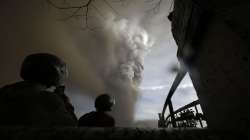16,700 evacuated as Philippines volcano spews lava
The displaced people were taken to 45 evacuation centres authorized by the authorities in the most affected municipalities of San Nicolas, Balete, Talisay, Lipa (Batangas province) and Tagaytay (Cavite), according to the National Disaster Risk Reduction and Management Council.

Some 16,700 people were evacuated on Monday as the Taal Volcano in the Philippines started spewing lava, while the ash fall reached the capital Manila, some 70 km away. The displaced people were taken to 45 evacuation centres authorized by the authorities in the most affected municipalities of San Nicolas, Balete, Talisay, Lipa (Batangas province) and Tagaytay (Cavite), according to the National Disaster Risk Reduction and Management Council.
The regional civil defence spokesperson, Lexie Masiglat, told Efe news that the evacuation protocol was still ongoing, meaning that the number of evacuees was set to continue increasing over the next hours.
Of those evacuated, some 2,000 people are residents of the small volcanic island on Lake Taal that is starting to erupt.
The Philippine Institute of Volcanology and Seismology (PHIVOLCS) raised the threat level from 1 to 4 on a scale of 5 after an increase in activity within Taal's crater resulted in the billowing of a huge plume of smoke that reached heights of around 1 km.
An alert level of 4 implies that a dangerous eruption could be imminent and that there is a risk of a volcanic tsunami, as Taal - one of the smallest volcanoes in the world - is located in the middle of the lake.
The director of PHILVOCS, Renato Solidum, said in a Monday press conference that the spewing of lava does not mean that the volcano has necessarily entered the dangerous explosive eruption phase, though he did not reject that possibility, either.
In the last 24 hours, up to 75 earthquakes of volcanic origin have been recorded, 32 of them of noticeable intensity, including one of magnitude 3.8 during early Monday morning.
Ninoy Aquino International Airport in Manila and Clark International Airport (about 90 km north of the capital), partially resumed operations after having been shut down due to lack of visibility, leading to the cancellation of at least 109 international and 87 domestic flights that left thousands of passengers stranded.
Educational institutions and government offices in Manila and Calabarzon region, where the provinces of Batangas and Cavite - most affected by the eruption - are located, have been suspended.
The areas surrounding the volcano have been covered by a thick layer of ash and toxic smoke, prompting the health department to recommend against going outdoors or using masks and glasses if doing so.
The department also discouraged people from driving, as visibility is limited and the ground has become slippery because of ash.
Teams from the Philippine Red Cross have moved to the area to assist in evacuation efforts, while the Philippine Armed Forces have been put on alert and sent five trucks to move evacuees.
The volcano, which has erupted 33 times since 1572, killed some 1,300 people in an eruption in 1911 and 200 in 1965.
Taal volcano is an island within the lake of the same name, located within a caldera formed by a previous eruption and is part of a volcanic chain that extends through the western region of the island of Luzon.
Also Read: Wilson Gavin, 21, at the centre of Drag Queen protests, found dead